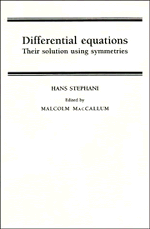Freshly Printed - allow 8 days lead
Couldn't load pickup availability
Differential Equations
Their Solution Using Symmetries
Hans Stephani (Author), Malcolm MacCallum (Edited by)
9780521366892, Cambridge University Press
Paperback, published 26 January 1990
276 pages
22.9 x 15.2 x 1.6 cm, 0.41 kg
"...Stephani...has built a book that tries to guide its readers toward a sure knowledge of this very important tool for finding solutions of (nonlinear) differential equations. In the early sections, the derivations presented are the most clear and detailed ones that this writer has ever seen....Students new to this area will find reading or studying the current book an altogether enjoyable occupation, without any of the intimidation that sometimes is caused by similar books." J.D. Finley, Foundations of Physics
This book provides an introduction to the theory and application of the solution of differential equations using symmetries, a technique of great value in mathematics and the physical sciences. In many branches of physics, mathematics, and engineering, solving a problem means a set of ordinary or partial differential equations. Nearly all methods of constructing closed form solutions rely on symmetries. The theory and application of such methods have therefore attracted increasing attention in the last two decades. In this text the emphasis is on how to find and use the symmetries in different cases. Many examples are discussed, and the book includes more than 100 exercises. This book will form an introduction accessible to beginning graduate students in physics, applied mathematics, and engineering. Advanced graduate students and researchers in these disciplines will find the book an invaluable reference.
Preface
1. Introduction
Part I. Ordinary Differential Equations: 2. Point transformations and their generators
3. Lie point symmetries of ordinary differential equations: the basic definitions and properties
4. How to find the Lie point symmetries of an ordinary differential equation
5. How to use Lie point symmetries: differential equations with one symmetry
6. Some basic properties of Lie algebras
7. How to use Lie point symmetries: second order differential equations admitting a G2
8. Second order differential equations admitting a G3IX
9. Higher order differential equations admitting more than one Lie point symmetry
10 Systems of second order differential equations
11. Symmetries more general than Lie point symmetries
12. Dynamical symmetries: the basic definitions and properties
13. How to find and use dynamical symmetries for systems possessing a Lagrangian
14. Systems of first order differential equations with a fundamental system of solutions
Part II. Partial Differential Equations: 15. Lie point transformations and symmetries
16. How to determine the point symmetries of partial differential equations
17. How to use Lie point symmetries of partial differential equations I: generating solutions by symmetry
18. How to use Lie point symmetries of partial differential equations II: similarity variables and reduction of the number of variables
19. How to use Lie point symmetries of partial differential equations III: multiple reduction of variables and differential invariants
20. Symmetries and the separability of partial differential classification
21. Contact transformations and contact symmetries of partial differential equations, and how to use them
22. Differential equations and symmetries in the language of forms
23. Lie-Backlund transformations
24. Lie-Backlund symmetries and how to find them
25. How to use Lie-Backlund symmetries
Appendices
Index.
Subject Areas: Differential calculus & equations [PBKJ]


